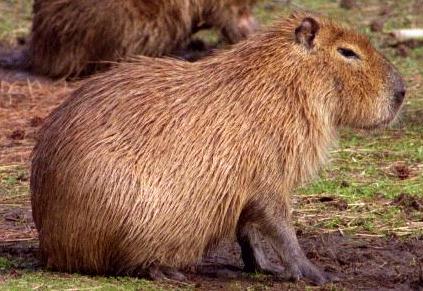![]()

BODY LENGTH:
100-130 cm (39-48 in)
HEIGHT:
Up to 50 cm at the shoulder.
WEIGHT:
27-79 kg (60-173 lbs)
RANGE:
Panama, East of the Andes Mountains in South America from Columbia and the Guianas to Uraguay and northeastern Argentina.
HABITAT:
Densely vegetated areas around ponds, lakes, rivers, and other bodies of water.
DIET:
Herbivorous; mainly grasses, also aquatic plants, grains, melons, and squashes. It is sometimes seen grazing with cattle.
BREEDING:
Usually 1 litter a year, 2 if conditions are favorable.
GESTATION:
About 149 to 156 days.
LITTER SIZE:
1-8, 5 on average. Young are precocial and are able to follow their mother and eat grass shortly after birth.
LIFE EXPECTANCY:
8-10 in the wild, 12+ in captivity
![]()
Capybara are the largest living memeber of the rodent family. They are covered with long, stiff hair that is so sparse that the skin is visible. The coloration of capybara is generally reddish brown to grayish on the upper parts and yellowish brown on the underparts. Occasionally there is some black on the face, the outer surface of the limbs and the rump.
Mature males have a bare, raised area on the top of the snout with is a scent gland used for marking objects with scent. Females lack the scent gland making it an easy indicator of sex in mature animals.
Capybara have short limbs and a relatively large, broad head. The ears are short and rounded. Their eyes are small and are located close to the top of the head. This allows the animal to surface to see and breathe without exposing much of itself to potential predators. This eye placement can be seen on several largely aquatic animals such as alligators and it's relatives and the hippopotamus. The capybara has four toes on it's front feet and three on its hind feet and they are partially webbed to aid in swimming.
In areas where they are not disturbed, capybara are active in the morning and the evening, resting during the heat of the day in a shallow bed in the ground. They make this bed by rolling repeatedly in a spot until it forms a depression. The depression fills with the water that is on the animals hair after it emerges from the water. I have witnessed this with our captive animals. They will swim in their pool and then will go lay down in their depression turning it into a wallow of mud. They will roll themselves in the wallow until they are covered in mud much like a hog.
In areas where they have been disturbed by people, they have become nocturnal. Other mammals such as the Bengal Tiger have turned nocturnal due to the disturbance by humans.
When alarmed on land, the capybara runs like a horse, and when closely pursued, it enters the water where it swims and dives with ease. While it is swimming, only the nostrils, eyes and ears project above the water. They can also swim completely underwater, often for considerable distances, or it may hide in floating vegetaion, exposing only its nostrils. Although it seems to be and aquatic mammal, water is used primarily as a place of refuge, and most normal activity is on land.
Capybara are commonly found in groups of about 20, though accounts of groups numbering 100 or more have been reported. Large groups appear not to be stable, possibly several groups seen at the same time at the same place. Capybara herds range from a pair or family to complex groups of several adults of both sexes and their offspring. A typical herd is controlled by a dominant male.
Capybara vocalize frequently. These sounds include low clicking sounds of contentment; sharp, prolonged whistles; abrupt grunts (alarm call, quite loud), and weak barks. The male that I take care of often emits a long, low, raspy grunt which I think is a territorial/breeding call which is done with his head outsretched, chin high, as he walks.
Though populations in certain areas have declined, the capybara remains common and widespread in much of South America. It has even been raised commercially on some ranches. Such ranching is thought to have the advantage of maintaining natural wetlands, rather than draining them as might be required in the case of intensive cattle raising.
![]()